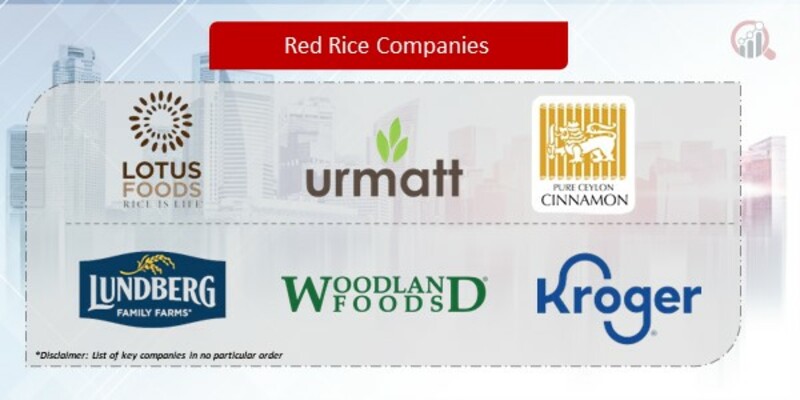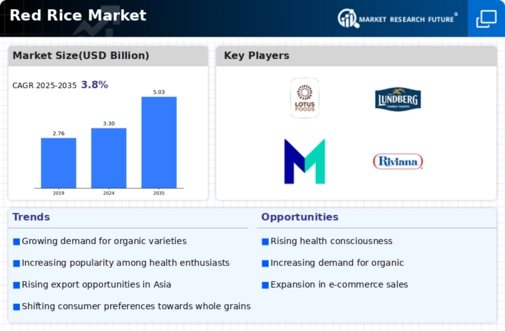Top Industry Leaders in the Red Rice Market

Strategies Adopted by Red Rice Key Players
The Red Rice Market is a significant segment within the global grains and cereals industry, characterized by key players involved in the cultivation, processing, and distribution of red rice. As of 2023, major companies shaping this market include LT Foods Limited, Amira Nature Foods Ltd., Kohinoor Foods Ltd., Lal Qilla, and Heritage Foods Limited.
Key Players:
LOTUS FOODS, INC
URMATT LTD
CEYLON PURE
Wuhan Jiacheng Biotechnology Co., Ltd.
Lundberg Family Farms
Woodland Foods, Ltd
The Kroger Co.
Mars, Inc.
Riviana Foods, Inc.
Fabrar Liberia, Inc.
The Red Rice Market revolve around product diversification, quality assurance, sustainability, market expansion, and strategic partnerships. Product diversification involves offering various varieties of red rice, such as organic, long-grain, and parboiled options, to cater to diverse consumer preferences. Quality assurance is paramount, with companies implementing stringent quality control measures, adhering to international food safety standards, and ensuring consistency in the quality of red rice products. Sustainability initiatives include promoting responsible agricultural practices, supporting local farmers, and adopting eco-friendly packaging solutions. Market expansion strategies involve entering new geographic regions and exploring emerging markets where consumer awareness of red rice benefits is growing. Strategic partnerships with retailers, foodservice providers, and health-focused organizations enhance distribution networks and market reach.
Market Share Analysis:
The Red Rice Market include brand reputation, product quality, pricing strategies, distribution channels, and responsiveness to consumer trends. Companies with established brand reputation often have a competitive advantage, as consumers tend to trust well-known brands for quality and authenticity. Offering high-quality red rice that meets health and nutritional requirements is crucial for gaining and maintaining market share. Pricing strategies, whether positioned as premium or competitively priced, impact market share by appealing to specific consumer segments. Efficient distribution channels, including collaborations with supermarkets, health food stores, and e-commerce platforms, contribute to market accessibility. Responsiveness to consumer trends, such as the demand for organic or specialty red rice, is vital for staying competitive in the dynamic market.
News & Emerging Companies:
The Red Rice Market has witnessed the emergence of new companies and trends responding to evolving consumer preferences and health-conscious lifestyles. Emerging companies often focus on unique red rice varieties, specialty blends, and sustainable farming practices to differentiate themselves in the competitive landscape. Additionally, innovations in packaging, such as eco-friendly and resealable options, have gained traction among emerging players seeking to attract environmentally conscious consumers.
Industry Trends:
The Red Rice Market highlight a continued focus on sustainability, nutritional benefits, and technology adoption. Many companies are investing in sustainable farming practices, including organic cultivation and water-efficient farming, to align with the increasing consumer demand for environmentally conscious products. Promoting the nutritional benefits of red rice, such as high fiber content and antioxidants, remains a key focus for companies looking to capitalize on health-conscious consumer trends. Technology adoption involves incorporating advanced processing technologies to enhance efficiency, reduce waste, and maintain product quality.
Competitive Scenario:
The Red Rice Market remains dynamic, with established players adapting to changing consumer preferences and emerging companies contributing to innovation. Market dynamics are influenced by factors such as the rising awareness of the health benefits of red rice, the popularity of specialty and organic products, and the growing demand for sustainable and responsibly sourced foods. The resilience of the market is evident in its ability to evolve, with companies addressing the diverse needs of consumers seeking not only nutritional benefits but also environmentally friendly and ethically produced red rice.
Recent Development
The Red Rice Market is the increased emphasis on sustainability, with major players actively communicating their commitments to responsible sourcing and eco-friendly practices. Companies have been investing in initiatives to reduce the environmental impact of red rice cultivation, such as water conservation and biodiversity preservation. This development aligns with broader industry trends and reflects the growing importance of sustainability in the global food market.
The Red Rice Market presents a competitive landscape shaped by key players adopting various strategies to meet the evolving demands of health-conscious consumers and navigate industry challenges. The emphasis on product diversification, quality assurance, sustainability, market expansion, and strategic partnerships underscores the industry's commitment to adapting to changing market dynamics. As the market continues to evolve, companies that can successfully balance nutritional benefits, environmental sustainability, and innovation are likely to maintain a competitive edge in the dynamic landscape of the Red Rice Market.


